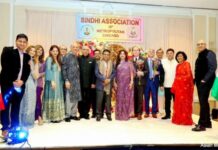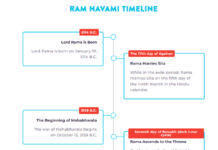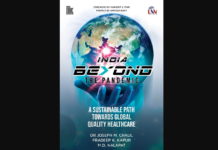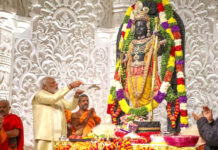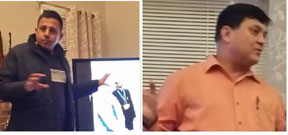
CANTON, MA: Journalist turned researcher Anuj Dhar held an inspirational and enlightening talk in Canton, MA on Tuesday October 11 attended by a good number of Indians interested to know about the findings of his research into the death of Netaji Subhas Chandra Bose.
Kanchan Banerjee, one of the organizers, welcomed and also thanked all for coming with so much enthusiasm and interest. He introduced in brief the author Anuj Dhar. He said that Dhar, a former journalist who wrote several books on Netaji Subhas Chandra Bose, had started researching into the disappearance of Netaji around 2001 and discovered some startling facts. He runs an NGO called Mission Netaji and has proposed several theories about Subhas Chandra Bose.
Dhar, who is very passionate about the topic, said that Netaji’s death is still covered with mystery. But the various conspiracy theories about it make it even more mysterious. He mentioned about some of the most thought-provoking conspiracy theories with some declassified documents and pictures: Netaji died in the plane crash. If that is true then why is there no dead body?
In the outcome, an exciting, and perhaps critical fact emerged: Netaji’s other lieutenants, who were to follow him on another flight, never saw his body. No one took photographs of Bose’s injuries or his body, nor was a death certificate issued. As news reached India, senior INA officer JR Bhonsle rejected the news. Mahatma Gandhi said, “Subhas is not dead. He is still alive and biding his time somewhere.”
Soon, rumors began doing the rounds that Bose was either in Soviet-held Manchuria, as a prisoner of the Soviet Army, or had gone into hiding in Russia. Lakshmi Swaminathan, of the INA’s Jhansi Regiment, said in 1946 she thought Bose was in China. Another story prevailed for some time that his bones and ashes are stored but DNA test was not yet done to confirm the fact and even most family members also did not show interest in the story.
In the 1950s, there emerged stories that Netaji had become a sadhu. And elaborative facts of this story took shape a decade later. Some of Netaji’s old associates formed the ‘Subhasbadi Janata’, and claimed Bose was now the chief sadhu in an ashram in Shoulmari in North Bengal. According to the ‘Subhasbadis’, Bose returned to India after the war, became a sadhu, attended Gandhi’s funeral unseen in 1948, lived in a temple in Bareilly in the late 1950s, before finally settling in Shoulmari as Srimat Saradanandaji in 1959.
Other versions, too, began gathering credence. Bose remained either in Maoist China or the Soviet Union. He attended Jawaharlal Nehru’s cremation in 1964, of which there appeared to be even photographic evidence.
According to the Soviet connection and a conspiracy theory, after independence, Nehru took the Foreign Affairs portfolio himself and appointed Vijaylakshmi Pandit as the ambassador to Russia. After her term, Dr. S. Radhakrishnan took her place. There are reports that Dr. Saroj Das, of Calcutta University, told his friend Dr. RC Muzumdar that Dr. Radhakrishnan had told him that Bose was in Russia.
In another report, former Indian ambassador Dr. Satyanarayana Sinha met CPI founder Abani Mukherjee’s son Georgey, who said his father and Netaji were imprisoned in adjacent cells in Siberia. In 1995, a team from Calcutta’s Asiatic Society found a bunch of declassified files that hinted at Bose having been in the USSR after 1945.
Dr. Purobi Roy, a member of the team of scholars, said she found a document stamped “most secret”, dated 1946, in the military archives of Paddolosk, near Moscow, which mentioned Stalin and Molotov discussing Bose’s plans – whether he would remain in the USSR or leave. Dr. Roy also said she found a KGB report in Bombay from 1946, which said, “it is not possible to work with Nehru or Gandhi, we have to use Subhas Bose”. This implies Bose was still alive in 1946.
Later in time, three enquiry commissions have been set up to inquire into the Bose mystery so far.
Justice Mukherjee ruled out the possibility of Bose dying in the air crash in his 2005 report. Pranab Mukherjee and his UPA government trashed Justice Mukherjee’s report and did not accept it. “Even in 1996, when a joint secretary level officer in the ministry of external affairs recommended that India should seek evidences on Bose’s presence in Russia from the KGB archives, the then external minister Pranab Mukherjee put it under wraps, on grounds that it would spoil the Indo-Russian relationship,” claims Dhar.
Anuj Dhar asserts that the death of Subhas Chandra Bose was the biggest cover up in the history of India. He did not die in the plane crash in Taiwan. In fact, no such plane crash ever took place. He was not either captured or killed by Stalin. He also talked about The Figgess Report of 1946, and The Shah Nawaz Committee of 1956.
Mr. Dhar raised several pertinent questions and examined the roles of several top leaders. He also examined Subramaniam Swamy’s claim that Netaji was done away with in the Soviet Union on the orders of Jawaharlal Nehru. He comes down to the present times and examined why the current Modi government is not able to take concrete steps on the Netaji files.
He says, of all this, the legend of a sadhu in Azizabad who was called Gumnami Baba, who went by the name Bhagwanji is more convincing but the truth has come out from the government declassified files. He lived in Uttar Pradesh – Lucknow, Faizabad, Sitapur, Basti and Ayodhya – for more than 30 years till his death on September 16, 1985. He maintained contact with Dr. Pavitra Mohan Roy, the former top Secret Service agent of the INA.
However, more than his life, what Bhagwanji left behind after his death seems to confirm that the sadhu and Bose were one and the same: Gold-rimmed spectacles identical to what Netaji was always pictured wearing, powerful German binoculars, a color photograph of Swami Vivekananda, Bengali books, the original copy of the summons issued to Suresh Chandra Bose to appear before the Khosla Commission, a map of undivided India, an album containing family photographs of Netaji Subhas Chandra Bose. Dhar confidently says that Bhagwanji’s handwriting samples had matched with the ones of Bose.
Dhar’s talk was very interesting and he supported his arguments with convincing documents and pictures. He spoke more than two hours and held the audience spellbound.
The talk was followed by Q&A session.
Dhar has written the well-known books concerning the controversy surrounding the fate of Subhas Chandra Bose: India’s Biggest Cover-up (2012) and What Happened to Netaji (2016) published and distributed by Vitastaa Publishing Pvt. Ltd. His book, What Happened to Netaji was recently launched in India.
Geetha Patil



